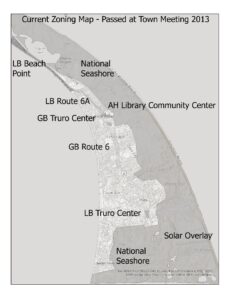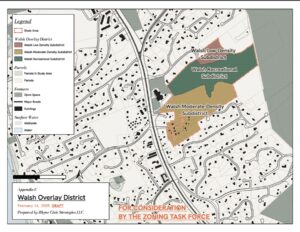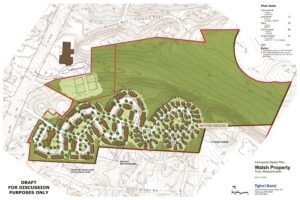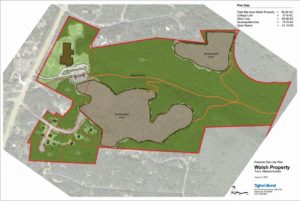TRURO — At a recent meeting with residents of Short Lots Lane, which runs just south of the 70-acre town-owned Walsh property, zoning task force chair David Bannard heard a now-familiar concern: that building new housing could jeopardize the town’s water supply.
How development at the Walsh property could affect water resources is “a question that comes up in every outreach session,” Bannard told the Independent. It’s a question that also shaped this year’s town meeting and the annual town election for seats on the select board and planning board.
At the town meeting on May 3, concerns over water protection were a rallying cry for critics of a new zoning plan for the Walsh property, including planning board chair Rich Roberts and clerk Jack Riemer, who argued that the town was moving too fast on housing without having addressed potential risks to groundwater.
Other speakers, including planning board vice chair Anne Greenbaum, said that presented a false choice because the issues could be addressed in tandem — but the vote on the zoning proposal was a close one, with 154 in favor and 127 opposed.
Warring Reports
Water has been a flashpoint here since at least 2019, when opponents of the Cloverleaf affordable housing project argued that it would contaminate the groundwater flowing toward the Pond Village neighborhood in North Truro.
In 2020, a group calling itself “Docs for Truro Safe Water” presented a report to the board of health that they claimed was peer-reviewed but misinterpreted the Cape Cod Commission’s standards on groundwater.
In 2021, opponents of the Cloverleaf development formed the “Truro Environmental Defense Fund” and hired hydrogeologist Thomas Cambareri to write a report about groundwater at the Walsh property.
Cambareri’s August 2022 report argued that all groundwater on the Walsh site — including any potential contaminants from wastewater and stormwater — flows toward the wellheads at North Union Field, which supply about 45 percent of the drinking water in Provincetown’s municipal system, and recommended prioritizing the property for protection as a future water supply site.
“Because of the vital reliance on the NUF wellfield, the Walsh master plan must prioritize the goal of groundwater protection,” Cambareri wrote. “It is essential to ensure that only conservation and low-impact recreational uses are allowed in the majority of the Walsh Property.”
Truro’s consultants, Environmental Partners, then asked the engineering firm McLane Environmental to review Cambareri’s findings. In a March 2024 report, McLane affirmed Cambareri’s conclusion that groundwater protection should be a priority at the site, writing that “the Walsh Master Plan must prioritize the goal of groundwater protection.”
The reviewers added that additional groundwater modeling should be done “to evaluate potential impacts associated with the development of the Walsh property on water quality at the NUF wellfield; both from potential wastewater inflows and from saltwater interface upconing.”
In January 2022, consultants Tighe & Bond had written that groundwater at the Walsh property would be expected to flow away from the North Union wellfield.
The town’s vision for the property has hinged on the installation of a cluster wastewater system that would connect new construction at Walsh, the adjacent Truro Central School, and a couple of nearby residential streets to a modern treatment facility that would reduce wastewater contamination to below its current level.
Such a system would “not only offset the new development at the Walsh property but actually result in a water quality improvement” in the area, Truro’s consultant Scott Horsley told the Provincetown and Truro select boards in October 2022.
Town Planner Barbara Carboni told the Independent last month that Cambareri’s credentials are not in question — but his work, and McLane’s review, are not shaping current planning.
“The reports reach different conclusions than the experts the town is relying on,” she said. “Our experts haven’t changed their minds after reading those reports.”
A Communication Plan
Bannard said that the zoning plan for the Walsh property would not affect or loosen existing water rules. “It would not allow anything outside of what the water protection overlay district allows,” he said.
There are people who won’t be persuaded by that, he added. “This is not just a town thing but a top to bottom distrust of government that started with Reagan,” he said.
To address misinformation and mistrust, town officials have launched new communication initiatives meant to clarify how the water system works, what protections are in place, and what is planned.
“We all want to protect the aquifer,” said select board clerk Nancy Medoff, who also serves on the Provincetown Water and Sewer Board, but that doesn’t mean development must stop.
“We can manage development while figuring out wastewater, traffic, zoning, and other infrastructure,” she said. “We can and must do it all at the same time.
“If someone hears something about the water supply, it is incredibly important that they make sure they are getting their information from a reliable source,” Medoff said. She encouraged residents to rely on subject matter experts at town hall for “clear, up-to-date, and scientific information.”
Acting Town Manager Kelly Clark told the select board on March 11 that the town was focused on outreach to “answer questions, provide facts, and maybe clear up misinformation about water.”
Marketing and communications coordinator Katie Riconda has been developing “Water Wednesdays,” a social media series focused on drinking water and the historic water-sharing relationship between Truro and Provincetown.
The town website now includes an online portal for residents to submit water-related questions and receive factual responses from staff. “Water touches a lot of issues people are concerned about,” Riconda said, but local government can be “really hard to follow.” The portal and a new water resources webpage aim to make it easier.
A “water communications team” including Clark, Riconda, Medoff, Carboni, DPW Director Jarrod Cabral, Health and Conservation Agent Emily Beebe, and other town staff are now meeting weekly to discuss water information and misinformation.
The aim is to help people understand a complex and serious issue, Riconda said.
Two key technical reports are now in development that could shape Truro’s future infrastructure: Beebe is working with the firm GHD to finalize a long-awaited draft of the town’s Comprehensive Wastewater Management Plan, while Cabral said he expects to receive a concept-level design for a new water storage tank by July.
Both plans will aim to improve current conditions and support new development.
“Water is a huge deal,” said select board chair Sue Areson on March 11. “We want to make sure that people have the most up-to-date information.”
“When there isn’t information,” said board member Sue Girard-Irwin, “and there is something going on, misinformation thrives.”









